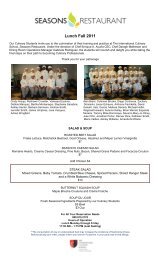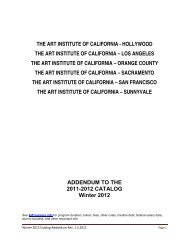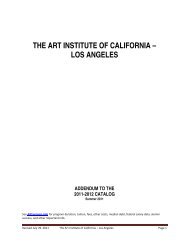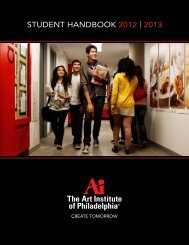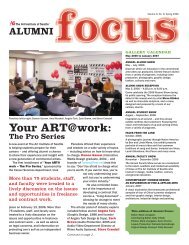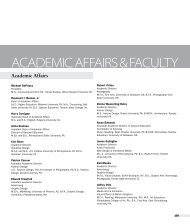2009 - 2010 Catalog - The Art Institutes
2009 - 2010 Catalog - The Art Institutes
2009 - 2010 Catalog - The Art Institutes
You also want an ePaper? Increase the reach of your titles
YUMPU automatically turns print PDFs into web optimized ePapers that Google loves.
FUNDAMENTALS OF GRAPHIC DESIGN<br />
Glossy magazines, compact disc covers, corporate identity<br />
systems, television graphics, billboards — all are composed<br />
of images, design, and printed words that work together to<br />
sell products and services or convey ideas. This is the fundamental<br />
concept of graphic design, and it’s the basis of some<br />
of today’s most dynamic fields — advertising, publishing, and<br />
television. <strong>The</strong> Graphic Design Associate in Applied Science<br />
degree program is the first step toward a career in commercial<br />
graphics. Initially, students develop an understanding of<br />
color, composition, design, typography, and drawing skills.<br />
WHAT WILL I LEARN?<br />
As students progress through the program, they are trained in<br />
creative problem solving and have the opportunities to learn<br />
to offer solutions that are effective in the business of graphic<br />
design. Emphasis is placed on learning the skills and techniques<br />
of computer graphics, electronic imaging, and production.<br />
Tools include scanners, digital cameras, and computerbased<br />
hardware and software. Advanced training includes the<br />
execution of assignments encountered by professionals in the<br />
field.<br />
PROGRAM MISSION<br />
<strong>The</strong> mission of the Graphic Design program is to provide a<br />
focus on conceptual thinking while developing graphic design<br />
technical and creative skills, including an introduction to<br />
the theory and practice of print and web design production,<br />
electronic publishing, graphic imagery, and sales promotion.<br />
Graduates are prepared to grow their careers from entry-level<br />
positions in the graphic design field through the practice of<br />
lifelong learning. Graduating students will be prepared to find<br />
entry-level positions as production artists, graphic designers,<br />
assistant designers, assist art directors, paste-up artists,<br />
production coordinators, and computer artists.<br />
22<br />
GRAPHIC<br />
DESIGN<br />
Associate in<br />
Applied Science<br />
7 Quarters<br />
PROGRAM OBJECTIVES<br />
Demonstrate competencies in industry-specific computer<br />
software programs within the context of producing concrete<br />
projects. This includes technical aspects of prepress, output,<br />
and quality reproduction, as well as web design.<br />
Incorporate aesthetics and formal concepts of layout and<br />
design. This includes spatial relationships; communication<br />
legibility and effectiveness; interrelationships among imagery<br />
and text; balance; typography; and color theory.<br />
<strong>Art</strong>iculate the vision behind their creative work and explain<br />
and promote their solutions.<br />
Demonstrate professional presentation; articulation of<br />
knowledge of graphic design and visual problem solving.<br />
GRADUATES ARE PREPARED<br />
By graduation, Graphic Design students have acquired the<br />
training and the portfolio necessary to interview for entry-level<br />
positions in advertising agencies, design studios, publishing<br />
houses, corporate communication’s departments, and television<br />
studios. Our graduates find work as production artists,<br />
graphic designers, assistant designers, assistant art directors,<br />
paste-up artists, production coordinators, and computer<br />
artists. <strong>The</strong> length of the program is seven (7), eleven (11)<br />
week quarters.



